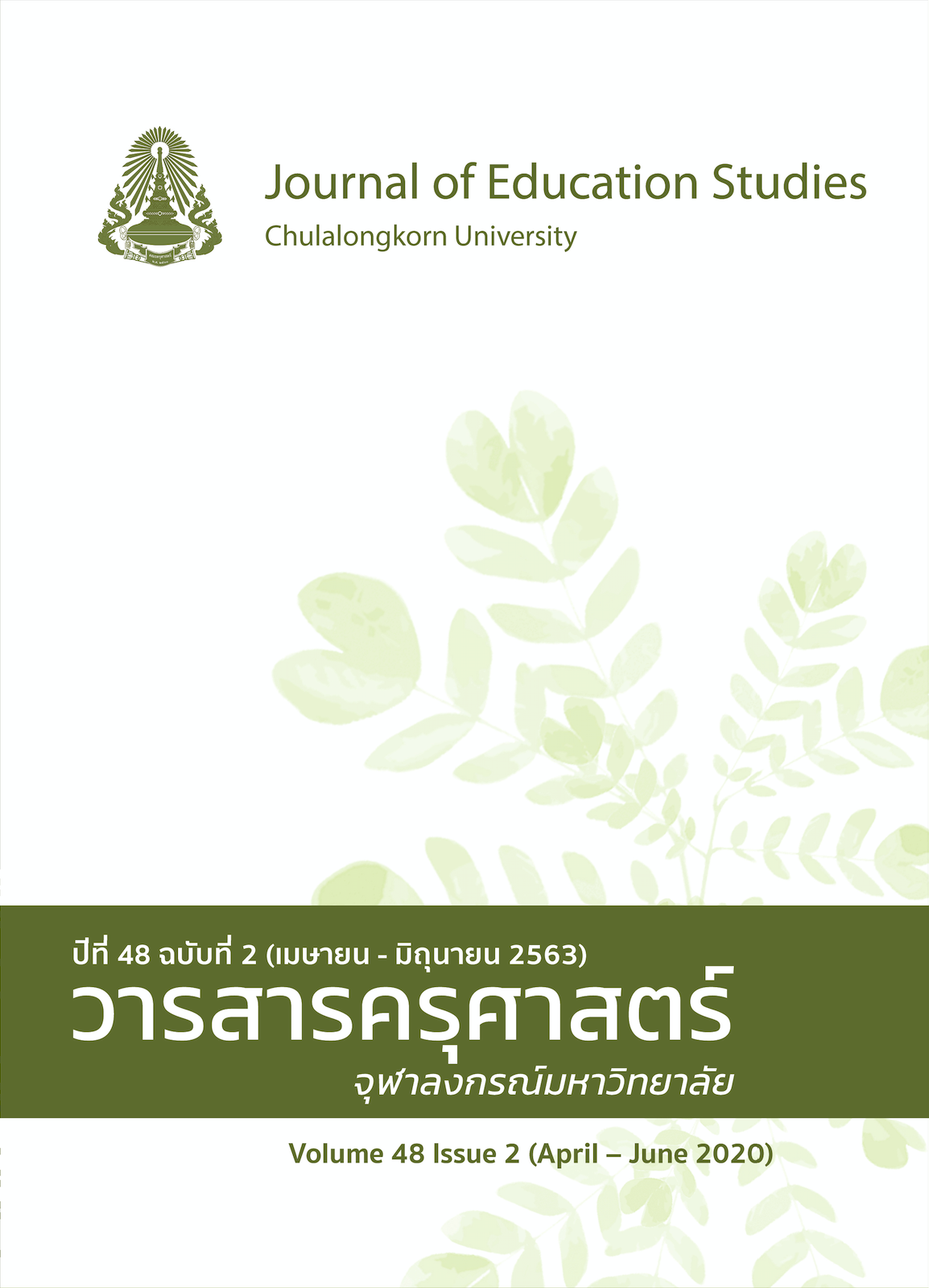Designing of Computational Science Learning Activities by Engineering Design Processes with Online Simulation to Enhance Problem-solving Abilities for Pre-cadet Students
Keywords:
learning activity, computational science, engineering design process, problem-solvingAbstract
This research aimed to develop and study the effects of using learning activities for computational science learning by using engineering design processes with online simulation to enhance problem-solving abilities for pre-cadet students. Samples were 20 pre-cadet students. Learning activity took 2 hours per day for 14 days, 28 hours in total, divided into two steps which were 1) preparing the learners (18 hours)- to develop basic knowledge and thinking methods among the learners, and 2) developing problem-solving ability (10 hours)- to give the learners solved assigned tasks by using the engineering design process. Six times measure using the problem-solving ability assessment form. Mean and standart deviation were used to analyzed the data. The results of the 6th evaluation were at very good level (M = 15.35, SD = 0.59). Moreover, the average satisfaction scores were at the highest level (M = 4.79, SD = 0.35).
References
กิ่งฟ้า สินธุวงษ์. (2009). การประเมินเพื่อพัฒนาการเรียนรู้. Journal of Burirum Rajabhat University, 1(2), 6-19.
กองวิชาวิทยาศาสตร์ โรงเรียนเตรียมทหาร. (2562). หน้าที่และภารกิจ. กองวิชาวิทยาศาสตร์. http://www.afaps.ac.th/~edbsci/website/index.php?p=mission
ขัณธ์ชัย อธิเกียรติ และ ธนารักษ์ สารเถื่อนแก้ว. (2559). การสอนแบบสมัยใหม่และเทคนิควิธีการสอนแนวใหม่. สำนักส่งเสริมวิชาการและงานทะเบียน มหาวิทยาลัยราชภัฏสงขลา. http://regis.skru.ac.th/RegisWeb/webpage/addnews/data/2017-07-24_078.pdf
ภานุพงค์ แสงฤทธิ์, ทรงศักดิ์ สองสนิท, และ สนิท ตีเมืองซ้าย. (2559). การพัฒนาบทเรียนบนเว็บที่ส่งเสริมความสามารถในการคิดแก้ปัญหา สําหรับการเขียนโปรแกรมคอมพิวเตอร์ ด้วยโปรแกรมจำลองเหตุการณ์หุ่นยนต์ สําหรับนักเรียนชั้นมัธยมศึกษาตอนปลาย. วารสารมนุษยศาสตร์และสังคมศาสตร์ มหาวิทยาลัยราชภัฏมหาสารคาม, 10(2), 95-104.
ศศิธร ชิดนายี. (2559). ความสำคัญของการเตรียมความพร้อมก่อนการเรียน Pm-Care model. วิทยาลัยพยาบาลบรมราชชนนี อุตรดิตถ์. http://www.unc.ac.th/bcnu/images/doc/บทความการเตรียมความพร้อมก่อนการเรียน%20PM.pdf
สถาบันส่งเสริมการสอนวิทยาศาสตร์และเทคโนโลยี. (2560). คำอธิบายรายวิชาเทคโนโลยี (วิทยาการคำนวณ). สาขาคอมพิวเตอร์ สถาบันส่งเสริมการสอนวิทยาศาสตร์และเทคโนโลยี (สสวท.). http://oho.ipst.ac.th/download/mediaBook/computing-science-course-description.pdf
สถาบันส่งเสริมการสอนวิทยาศาสตร์และเทคโนโลยี. (2561). สรุปภาพรวมหลักสูตรและตัวชี้วัด ง.3.1 เทคโนโลยีสารสนเทศและการสื่อสาร หลักสูตร 2551 กับ ว.4.2 เทคโนโลยี (วิทยาการคำนวณ) หลักสูตรปรับปรุง 2560. สาขาคอมพิวเตอร์ สถาบันส่งเสริมการสอนวิทยาศาสตร์และเทคโนโลยี (สสวท.). http://oho.ipst.ac.th/download/mediaBook/cs-ict.pdf
หน่วยศึกษานิเทศก์ สำนักงานคณะการการอาชีวะศึกษา. (2558). แนวทางการจัดการเรียนรู้แบบโครงงานเป็นฐาน. สำนักงานคณะกรรมการการอาชีวศึกษา.
ภาษาอังกฤษ
Anderson, T. (2015, July 7). Why the BBC is stuffing free micro: Bit computers into schoolkids' satchels. The Register. https://www.theregister.co.uk/2015/07/07/bbc_microbit_final_specification_announced_a_million_devices_to_be_flung_at_schools_in_october/
Canter, A. (2004). A problem-solving model for improving student achievement. Semantic Scholar. https://pdfs.semanticscholar.org/72f1/322102abfe42c3c8f40d7139a0c88100415b.pdf
Dale, N. (2010). Programming and problem solving with C++: Comprehensive (5th ed.). Boston, Jones and Bartlett Publishers.
Fadi, K., Lee, S., & Lauren, R. (2016). Exploring mind mapping techniques to analyse complex case study data. Australian Academy of Business and Economics Review, 2(3), 1-15.
Hill, R. (2006). New perspectives: Technology teacher education and engineering design. Journal of Industrial Teacher Education, 43(3), 45-63.
Hockney, R. W., & Eastwood, J. W. (1988). Computer simulation using particles. Taylor & Francis.
Iiyoshi, T., Hannafin, M., & Wang, F. (2005). Cognitive tools and student-centred learning: Rethinking tools functions and applications. Educational Media International, 42, 281-296. https://doi.org/10.1080/09523980500161346
Lajoie, S. (2000). Computers as cognitive tools: No more walls, vol. II. Lawrence Erlbaum Associates Publishers.
Law, A., & Kelton, D. (1991). Simulation modeling and analysis (2nd ed.). McGraw-Hill.
Lertyosbordin, C., Maneewan, S., Yampinij, S., & Thamwipat, K. (2019). Scoring rubric of problem-solving on computing science learning. International Education Studies, 12, 26-32. https://doi.org/10.5539/ies.v12n8p26
Lewis, T. (2004). A turn to engineering: The continuing struggle of technology education for legitimization as a school subject. Journal of Technology Education, 16(1), 21-39.
Majid, M., Aickelin, U., & Siebers, P. (2013). Modelling reactive and proactive behaviour in simulation: A case study in a university organisation. SSRN Electronic Journal, 1(1), 1-2.
Mangold, J., & Robinson, S. (2013, June 23-26). The engineering design process as a problem solving and learning tool in K-12 classrooms [Paper presentation]. ASEE Annual Conference & Exposition, Atlanta, Georgia. https://peer.asee.org/22581
Maria, A. (1997). Introduction to modeling and simulation. In A. Sigrún, J. Kevin, H. David, & L. Barry (Eds.), Winter simulation conference: Vol. 29 (pp. 7-13). IEEE Computer Society.
Matt, B. (2015). How the BBC' s micro:bit came to be. Engadget. https://www.engadget.com/2015-07-07-bbc-micro-bit-explained.html
Microsoft MakeCode. (2018). About makecode. Documentation. https://makecode.com/about
Museum of Science Boston. (2017). The engineering design process. EiE. https://eie.org/overview/engineering-design-process
National Academy of Sciences. (2013). The standards-arranged by disciplinary core ideas and by topics. The National Academic Press.
National Aeronautics and Space Administration [NASA]. (2015). Engineering design challenge facilitation guide. https://www.nasa.gov/sites/default/files/files/EDC-02_Let_It_Glide_Facilitation_Guide_FINAL.pdf
Nishadha, S. (2018). Using gantt charts and flowcharts in project planning. Creately. https://creately.com/blog/diagrams/using-gantt-charts-flowcharts-project-planning/
Partnership for 21st Century Skills. (2017). Assessment: A 21st century skills implementation guide. Battle for Kids. http://www.p21.org/storage/documents/p21-stateimp_
assessment.pdf
Randy, L., Julie, G., & Julie, L. (2010). Technology in the secondary science classroom. NSTA Press.
Sebastian, A. (2015). BBC micro:bit-a free single-board PC for every year 7 kid in the UK. ARSTechnica. https://arstechnica.com/gadgets/2015/07/bbc-microbit-a-free-single-board-pc-for-every-year-7-kid-in-the-uk/
Smith, R., & Alder, S. (2011). IB design technology standard & higher level. OSC.
United Nations Educational, Scientific and Cultural Organization. (2017). The four pillars of learning. UNESCO Institute for Lifelong Learning. https://uil.unesco.org/fileadmin/keydocuments/LifelongLearning/en/UNESCOTechNotesLLL.pdf
Vincini, P. (2003). The spectrum of cognitive tools. Academic Technology at Tufts. Tufts. http://sites.tufts.edu/ets/files/2012/12/newsletter_apr_20031.pdf
Wicklein, C. (2006). Five good reasons for engineering design as the focus for technology education. Technology Teacher, 65(7), 25-29.




